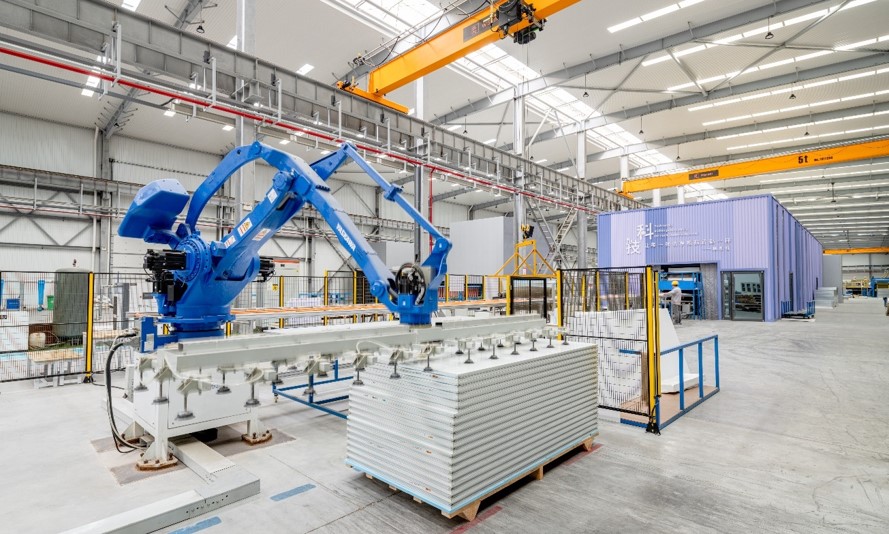Difference between polyurethane sandwich panel PIR and PU

There is an increasing demand for polyurethane sandwich panels in today’s industrial systems. When used in cold storage projects, it has an excellent thermal insulation effect. While both types of these insulation materials feature great benefits regarding energy efficiency, they have some notable differences between them in properties, performance, cost-effectiveness and more. today we will talk about the difference between PIR and PU polyurethane sandwich panels.
What is a PU sandwich panel
PU, is an isocyanate and polyol reaction and made of polymers with urethane chain segment repeating structural units, excellent material properties, wide range of uses, a variety of products, the most extensive use of PU foam, PU products are divided into two categories of foaming products and non-foaming products, foaming products are flexible, rigid, semi-rigid PU foam; non-foaming products include coatings, adhesives, synthetic leather, elastomers and elastic fibers. PU products are divided into two categories: foamed products and non-foamed products; foamed products include flexible, rigid and semi-rigid PU foam; non-foamed products include coatings, adhesives, synthetic leather, elastomers and elastic fibers. It is usually used in the wall and roof enclosure system of industrial plants, logistics storage and integrated houses.
Polyurethane is used in insulation for its ability to provide excellent thermal insulating properties and its low water absorption rate. It is also extremely resistant to fire and offers good abrasion resistance and tensile strength. PU sandwich panel is also able to be easily cut, machined, and formed into shapes, making it particularly well-suited for insulated sandwich panels.
What is a PIR sandwich panel
PIR, is made from isocyanate by the catalytic effect and polyether reaction made of foaming materials, physical and fire resistance than the general polyurethane is more excellent, is an ideal organic low temperature thermal insulation materials. It has small thermal conductivity, light weight and shockproof, and strong adaptability. It is widely used in oil refineries, chemical plants, ethylene, chemical fertilizers, cold storage and thermal insulation in the construction industry. It is similar to polyurethane in that it provides excellent thermal insulating properties and has a low water absorption rate.
However, it has a much higher compressive strength and fire resistance than polyurethane. PIR sandwich panel is also a great material for insulation in sandwich panels due to its excellent thermal insulation characteristics and improved compressive stre ngth.
The differences between PU and PIR sandwich panel
PU and PIR sandwich panels are two different types of insulation material, with different properties.
Difference in fire resistance
PIR has a much higher fire rating than PU and is able to withstand higher temperatures, making it an ideal choice for applications that are subject to fire.
PU : generally B3 grade, by adding flame retardants, it can reach B2 grade.
PIR: generally B2 grade, by adjusting the concentration of polyisocyanurate acid ring and other formula technology, it can reach the B1 level, and the oxygen index can reach more than 35%.
Difference in thermal insulation properties
PU: the thermal conductivity is generally 0.022 to 0.026 W/mk (25 degrees Celsius)
PIR : thermal conductivity can be as low as 0.018 W/mK (25 degrees Celsius)
The two materials also differ in their thermal insulating properties. PU is slightly better than PIR in this regard, providing a slightly higher R-value. This means that PU is better at providing thermal insulation from temperatures outside the building.
Compressive strength
Due to the difference in bulk density between the two, there is a difference in compressive strength.
PU : generally achieve 35-45kg/m3, in order to achieve satisfactory strength requirements .
PIR: generally achieve 45-55kg/m3, in order to achieve satisfactory strength requirements.
PIR has much higher compressive strength which means it can better handle heavy loads or stress from water.
Difference in water absorption
PU : generally 2.5 to 3%. PIR : up to 0.9%. PIR is slightly better than PU in its moisture resistance, meaning it can better handle changes in humidity. This makes it an ideal choice for insulated sandwich panels when water or moisture is a factor.
In conclusion, both PU and PIR sandwich panels are great products for insulation and cladding. However, it is important to understand the differences between them. PU sandwich panels offer better thermal insulation and flexibility but are not as flame resistant as PIR sandwich panels. Meanwhile, PIR sandwich panels offer better fire protection and airtight seals. Depending on the application and requirements, one type may be more suitable than the other. Therefore, it is important to consider the different properties and appraise the best option for the project.
Hi, this is a comment.
To get started with moderating, editing, and deleting comments, please visit the Comments screen in the dashboard.
Commenter avatars come from Gravatar.